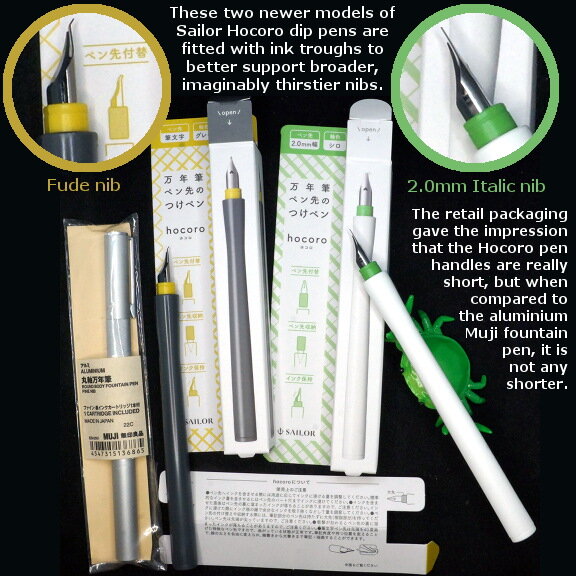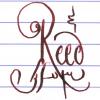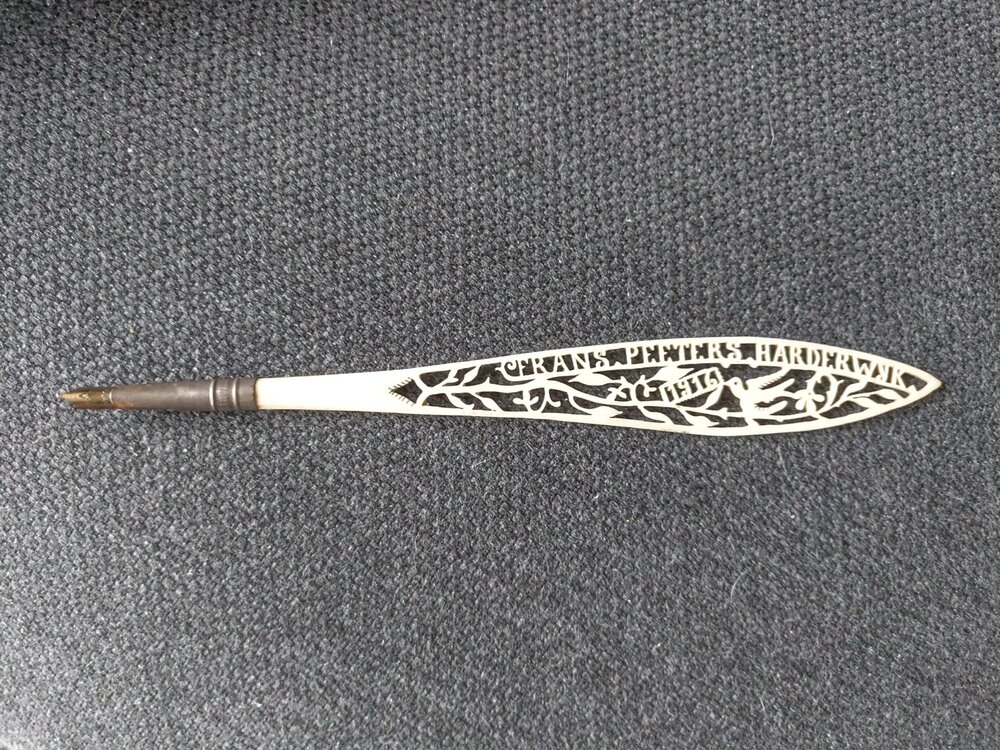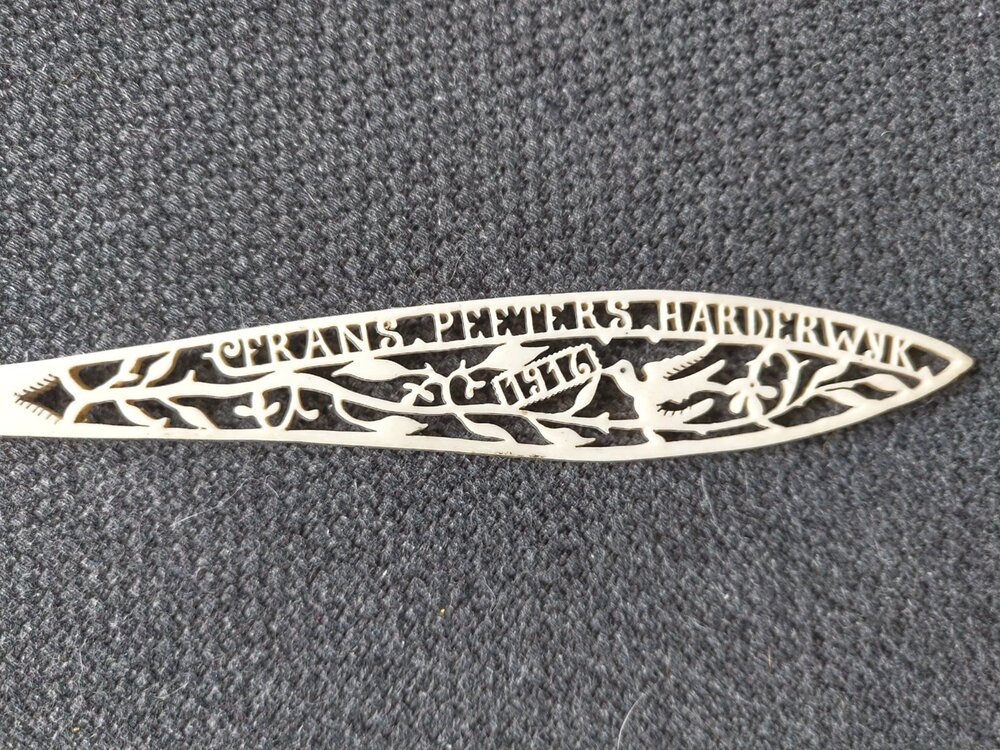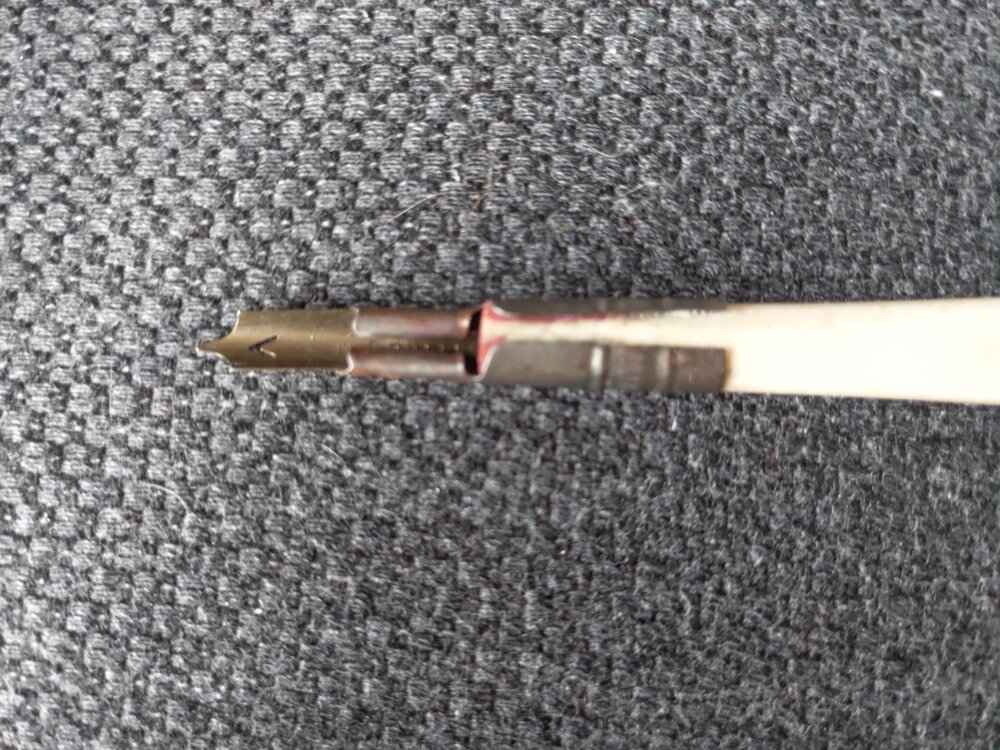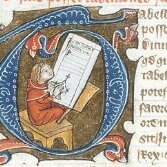Search the Community
Showing results for tags 'dip pen'.
-
Found some nibs while hanging out before work earlier this week but the only holder I could find was way to narrow for my fat fingers, so a trip to the hardware store and a little elbow grease later and I have a holder tuned for each style of nib I know they are a little crude but they work :3
-
I once read a similar post about fountain pens on FPN. Since there are many dip pen users and collectors in FPN, I thought it would be interesting to know what is the oldest one in their possession. My humble collection consists of just three dip pen holders. One is a modern wooden straight holder and the other two are the oldest ones. I know this one is old but I couldn't figure out the exact time period. It's not very clear, but upon close inspection one can see "Calcutta" (old name of Kolkata, capital city of West Bengal state in India) imprinted on it. The second dip pen is much more dipped into history. It was gifted to me by one of my father's friend (in fact, the first one is also his gift). It belonged to his grandfather, Manoranjan Sengupta, who happened to be an Indian freedom fighter and a companion of the famous Indian revolutionary "Bagha" Jatin. (Here is the link of the Wikipedia page on Bagha Jatin. You will also find the name of Manoranjan Sengupta mentioned in the 'Death' section. https://en.m.wikipedia.org/wiki/Bagha_Jatin ) If Manoranjan Sengupta himself didn't inherit the holder from one of his predecessors then I think it might be from the early decades of 1900. I am not sure about the material of this pen. It feels somewhat like buffalo horn. Another possibility is laquer (must be hundreds of layers if it is really so) on wood. I am pretty proud of this holder. It thrills me when I hold it in my hand knowing that it was once used by a great man who sacrificed his life for the freedom of my nation. Now it's your to turn to tell me about the oldest dip pen in your collection.
-
Generally, I am not a fan of dip pens. Although most of my serious calligraphy friends, especially the professionals, use them by preference. Dip pens and I have never gotten along very well. The only type I have used in recent years is glass dip pens for ink testing. When I came across the Sailor hocoro pens by chance browsing an Italian pen shop's web site, I was sufficiently intrigued by several of its features to order one to try out. I ordered one with a 2.0mm italic nib and liked it enough to then order one with a 1.0mm italic nib. The things I like about the design include: 1) The relatively small size, making it very portable (unlike the usual dip pen). 2) The nib hides in the handle when not in use and is protected from damage. 3) The 2.0mm nib comes with a feed and a separate feed can be ordered for the 1.0mm nib. With the feed, the nib holds enough ink for quite a lot of writing, and flow is very good. 4) The pen handle is comfortable to hold, and it has one flat side which keeps it from rolling away. 5) A quick wash with water cleans the nib. The text produced is quite acceptable. Even the 1.0mm italic nib produces good thick/thin line differentiation. Here are some photos: I expect this to become my first line ink testing pen. We'll see how I feel about it after more experience. David
-
- sailor hocoro
- dip pen
-
(and 1 more)
Tagged with:
-
Sailor hocoro Dip Pen For quick testing of fountain pen inks, a dip pen is a useful tool. I like the convenience it provides: dip it in the ink bottle, write a quick line. Then rinse under the water faucet and you're done. For the past year or so I’ve been using a Pilot iro-utsushi dip pen. That works well, but it doesn’t have a feed to function as an ink reservoir. So it’s only good for writing a few words. Recently I came across the Sailor hocoro dip pen (at stiloestile.it) : same concept, but this dip pen comes with a feed. It looked like a better alternative, so I decided to give it a try. The Sailor hocoro dip pen is basically a nib attached to a holder so you can write with it. The nibs can be bought separately, and come in different sizes (fine, a couple of stubs, fude). All nib units can be bought separately for about 10 EUR. Nib + holder come at about 15 EUR. Really affordable. The hocoro nib holder has two interesting features: It has a flattened surface on one side, which functions as a built-in roll-stop. A small but well-thought out detail. One side of the holder functions as a nib container. You can “cap” the nib in it so that it is protected. When you want to write with the dip pen, you pull out the nib, reverse it and plug it into the holder. Works really well. The biggest plus of this little dip pen is the integrated feed which serves as an ink reservoir (the F-nib comes without a feed, but the latter can be purchased separately. Broader nibs come standard with a feed). Because of this integrated feed, it’s possible to write a couple of lines without redipping the pen into the ink. Quite convenient, and ideal for a quick note without having to fill a full pen. I got me the hocoro dip pen with a “fude” nib. This looked like an interesting nib choice, and it really is! Depending on the angle you write, you can go from a fine to a very very broad line. Ideal for calligraphy fans. But also really nice when testing a new ink. The included packaging is simple piece of carton, with the instructions printed on it. One look at these, and you know how the pen works. I took a quick photo, and then got rid of it. As a dip pen, this Sailor hocoro works as advertised. It’s no beauty queen, but due to the integrated feed it is a really functional instrument. For testing inks it is an order of magnitude better than a glass dip pen. I also prefer it over the much better looking Pilot iru-utsushi. If you’re looking for a cheap dip pen for quick ink testing, you can’t go much better than this. And I can really recommend the “fude” nib which provides tons of line variation. Check it out…
-
From the album: OldTravelingShoe's Random Pics of Fountain Pens (2)
© (c) 2022 by OldTravelingShoe. All rights reserved.
- 0 B
- x
-
From the album: OldTravelingShoe's Random Pics of Fountain Pens (2)
© (c) 2022 by OldTravelingShoe. All rights reserved.
- 0 B
- x
-
i am a traditional jewish kosher torah scribe, and this requires the use of IG inks on parchment, the IG is usually very thick and many scribes use dip pens for this reason. the ink (https://merkazhasofrim.com/sofrus/inks/hadar-ink.html) lays on top of the parchment and stays as a shiny layer. i myself use a architect nib on a twsby vac700r but i am thinking of getting an oblique and holding the flat part of the nib perpendicular to the top pf the paper to acheive this same angle and variation. the issue is that it will in all likelyhood dry on my pen and become unusable. does anyone know how the IG/thick dip inks write with the indigraph or have reccommendation for a pen for thick ink?
-

Pilot iro-utsushi dip pen
namrehsnoom posted a topic in It Writes, But It Is Not A Fountain Pen ....
Pilot iro-utsushi Dip Pen For quick testing of fountain pen inks, I typically use a J. Herbin glass dip pen. I like the convenience it provides: dip it in the ink bottle, write a quick line. Then rinse under the water faucet and you're done. The biggest problem I have with the glass dip pen is that it's fiendishly difficult to control the ink flow. More often than not, I get a big blob of ink on the paper. Recently I bumped into this simple Pilot iro-utsushi dip pen (at stiloestile.it) . It looked like a better alternative, so I decided to give it a try. The Pilot iro-utsushi dip pen is basically a nib (F or M) attached to a holder - nothing fancy, no feed, just a nib with a handle to grip it. These dip pens come in two varieties: a cheap 8.50 EUR version in plastic, and a more luxurious 21.90 EUR version with a wood handle. I got me the maple wood version with M-nib because it's more elegant and just looks better than the plastic stuff. The nib is non-removable, so if you want multiple widths, you need to buy separate dip pens. I don't consider this a problem: the purpose of this dip pen is quick ink testing and comparison, not doing a long writing session. This dip pen looks great, and serves its purpose well. Doing a short writing sample is quick and easy, and cleaning the nib literally takes only a few seconds (rinse and dry). One thing I don't like is that the nib is protected with a cheap plastic slip-on cylinder - the kind you also use with paintbrushes. It works and is functional, but just doesn't look great. I wish Pilot had come up with a better solution for protecting the nib - a click-on cap perhaps? The above jars me a bit, because Pilot usually has more eye for detail. Take e.g. the built-in roll-stop. Part of the handle at the underside of the nib has been levelled, creating a flat surface that functions as a roll-stop. An ingenious idea, and one that does the job really well - nicely executed. As a dip pen, this Pilot iro-utsushi works as advertised. There is no feed to contain and regulate ink flow, so writing is still not perfect, but it's exponentially better than the uncontrolled behaviour I get with a glass dip pen. Writing a short sample to test an ink is much more akin to what you will get with an actual fountain pen. So if you currenly use a glass dip pen for ink testing, this might be a valuable alternative. Check it out...- 2 replies
-
- pilot
- iru-utsushi
-
(and 1 more)
Tagged with:
-
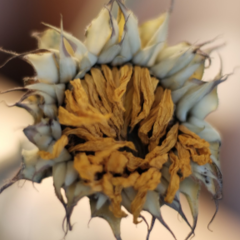
Pilot iro-utsushi: Dip pen type writing tool with a fountain pen tip
peroride posted a topic in Market Watch
Coming June 20 2022 - iro-utsushi -
Hello all and thank you in advance for your time here. I have a mother of pearl dip pen with a Spencerian number 3 nib in it which I bought a few years back at a local garage sale. It’s about 6 or 7 inches long, appears to be made of mother of pearl and sterling silver and ends in an ornate floral motif with a silver back. I can’t find any makers marks or forge marks on the silver parts of the pen. The pen came in a worn out black case, but one which seems to have been quite nice when it was new. At this point the only information I have comes from the Spencerian nib which seems to be from around the turn of the century. That and a note which came with the pen that reads “I think this pen belonged to my mother” ~Elsie. The woman I bought the pen from was in her early 70s and said that Elsie was her mother. Which seems to track with the turn of the century nib. Hopefully one of the experts on this forum will see this and know more information about this pen. It rights fairly smoothly still, I am a total amateur but I enjoy drawing and the qualities of this pen are quite nice for fairly fine line work. Anyway thanks again for any help identifying this and helping me shed a bit more light on this pen’s history.
-
I was wondering if anyone has used Ackerman pens. You can use almost any ink in them with a choice of dip pen nibs... They have overfeed/ pumps etc. It seems almost to good to be true... Any personal experience would be appreciated. Thanks!
-

What is you favorite pen holder you have used, straight or oblique.
Finriel posted a topic in Fountain & Dip Pens - First Stop
Hey y’all wondering what are some great pen holders straight and oblique. Also wondering about good dip pen ink. thanks in advance!- 14 replies
-
- pen holder
- dip pen
-
(and 1 more)
Tagged with:
-

What is in your opinion the best flex nib, pen ever?
Finriel posted a topic in Fountain & Dip Pens - First Stop
- 24 replies
-
- flex nib
- fountain pen
-
(and 2 more)
Tagged with:
-
Hello everyone 😊, greetings from the Netherlands! Happy to be here in the Fountain Pen Network 😁 I need your expertise. I've acquired this striking, antique personalized dip pen made of ivory from a reputable auction house. Aside from certifying the authenticity and legality of the item, they don't have information such as: Were pens like these made for military personnel, artists, medical staff at that time, etc? Were these given as an acknowledgement of a notable contribution or because of a special event? Was personalization of pens like these typical back then? I'm a complete novice on fountain pens and after hours of research, I couldn't find any leads. I just want to know the story behind it. I did find some Frans Peeters during that time period: one was a soldier, one was an artist and another one was a Belgian architect. I don't know if the any of them is the Frans Peeters I'm looking for. Perhaps it's best I approach a Dutch govt. body on public records. Any info would be greatly appreciated 🙏🏻
-
.thumb.jpg.fa47f5f051e847ecf4396ad6c7a7554f.jpg)
📌 Expertise needed: Rare antique European dip pen
Erika posted a topic in Fountain & Dip Pens - First Stop
Hello everyone 😊, greetings from the Netherlands! Happy to be here in the Fountain Pen Network 😁 I need your expertise. I've acquired this striking, antique personalized dip pen made of ivory from a reputable auction house. Aside from certifying the authenticity and legality of the item, they don't have information such as: Were pens like these made for military personnel, artists, medical staff at that time, etc? Were these given as an acknowledgement of a notable contribution or because of a special event? Was personalization of pens like these typical back then? I'm a complete novice on fountain pens and after hours of research, I couldn't find any leads. I just want to know the story behind it. I did find some Frans Peeters during that time period: one was a soldier, one was an artist and another one was a Belgian architect. I don't know if the any of them is the Frans Peeters I'm looking for. Perhaps it's best I approach a Dutch govt. body on public records. Any info would be greatly appreciated 🙏🏻 -
Hello everyone 😊, greetings from the Netherlands! Happy to be here in the Fountain Pen Network 😁 I need your expertise. I've acquired this striking, antique personalized dip pen made of ivory from a reputable auction house. Aside from certifying the authenticity and legality of the item, they don't have information such as: We're pens like these made for military personnel, artists, medical staff at that time, etc? Were these given as an acknowledgement of a notable contribution or because of a special event? Was personalization of pens like these typical back then? I'm a complete novice on fountain pens and after hours of research, I couldn't find any leads. I just want to know the story behind it. I did find some Frans Peeters during that time period: one was a soldier, one was an artist and another one was a Belgian architect. I don't know if the any of them is the Frans Peeters I'm looking for. Perhaps it's best I approach a Dutch govt. body on public records. Any info would be greatly appreciated 🙏🏻
-
Hello everyone 😊, greetings from the Netherlands! Happy to be here in the Fountain Pen Network 😁 I need your expertise. I've acquired this striking, antique personalized dip pen made of ivory from a reputable auction house. Aside from certifying the authenticity and legality of the item, they don't have information such as: Were pens like these made for military personnel, artists, medical staff at that time, etc? Were these given as an acknowledgement of a notable contribution or because of a special event? Was personalization of pens like these typical back then? I'm a complete novice on fountain pens and after hours of research, I couldn't find any leads. I just want to know the story behind it. I did find some Frans Peeters during that time period: one was a soldier, one was an artist and another one was a Belgian architect. I don't know if the any of them is the Frans Peeters I'm looking for. Perhaps it's best I approach a Dutch govt. body on public records. Any info would be greatly appreciated 🙏🏻
-
I recently acquired some walnut ink crystals from Paper & Ink Arts. This makes a very beautiful ink (not entirely dissimilar to J. Herbin's Cacao du Brésil, but browner overall), which seems pretty smear resistant when dry, but is not at all waterproof. I've added a bit of gum arabic, which I think improves the behaviour for the dip pen, but also seems to do nothing for waterproofing. (Iron Gall inks obviously might have more waterproofing, but I don't really want to use these with a dip pen, I don't think.) Thinking about "India inks", some of which have water-resistance, I was wondering about mixing shellac into the walnut ink. I see recipes for carbon black ink with shellac, but I haven't seen any for walnut-based inks. I don't see any reason why this shouldn't work though. Does anyone have any experience doing something like this? (I see a variety of shellac flakes are available, from very light-coloured "Platina" to "Blonde" to "Orange" to "Garnet"; I don't know if for the amount of shellac that one would add to an ink the colour of the flakes would make much difference. At least one of the ink recipes I saw for carbon-black ink called for pulverising the flakes, I suppose this is better than dissolving in alcohol when thinking about use on a dip pen?)
-
Hello! It's been a long time since I've posted here, but I thought that the deal I found last week might intrigue some folks (with pictures). Apparently the Dollar Tree (US-based store where all items are priced at $1) is now in the business of selling glass pens + coordinating ink! Quite surprisingly, it's not too scratchy and does a great job retaining ink between dips, both with the provided ink and other FP inks (I have not yet tested it with shellac-based inks.) The provided ink bottle is 6.8ml (0.23 fl oz) in a dark, mossy green which matches the pen shaft. Very slight shading.
-
Cone-shaped mystery - Usage, manufacturer, place to find?
Rawrik posted a topic in Fountain & Dip Pens - First Stop
Hello there, Took an interesting hobby to hoard weird, unusual, peculiar nibs to find new means of calligraphy. Recently, I've bought a whole little box stuffed with old nibs in antiques in Prague and I encountered this little guys. I can't really identify them, no matter how my english description is plaguing Uncle Google. This nibs?/cones?/resevoirs? whatever isn't working anymore, but apparently you drip some ink in it and the stick in the end of cone will let ink down by pressing it against papper (hence the spring). That's just so much to my reverse engineering. I tried to let it stay in warm water to clean content in it, solve the rust away in vinegar and brush it of in baking soda. None of it make it better. I'm looking forward to buy a new one, but there is nothing like brand or signature of manufacturer, which would hint its origin. So I figured out that you, guys, may help me. Tried to find it here for what felt like hours, so I submit this thread (after I sign up to this amazing community!). It may be regular model of some stationary tool I didn't know about, or some rare oddity not really used in any time. tags I used in forum, google: cone, funnel, nib cone-shaped, unusual nibs, calligraphy dip cone type, so on.. (I really tried) Value every opinion. (mobile photos, bad quality :(( )- 24 replies
-

Looking For Alternatives To Glass Dip Pens.
JayHomeBody posted a topic in Fountain & Dip Pens - First Stop
I was wondering if there are dip pens that are made from other materials than metal or glass. I suppose ceramic or acrylic would make for a good substitute for a complete glass dip pen. Or maybe wood, with a rounded point and with spiral grooves in it, similar to a glass pen. All I see are glass dip pens and metal nibs that attach to a handle. I can't find anything else. Help? -

Looking For Alternatives To Glass Dip Pens.
JayHomeBody posted a topic in Fountain & Dip Pens - First Stop
I was wondering if there are dip pens that are made from other materials than metal or glass. I suppose ceramic or acrylic would make for a good substitute for a complete glass dip pen. Or maybe wood, with a rounded point and with spiral grooves in it, similar to a glass pen. All I see are glass dip pens and metal nibs that attach to a handle. I can't find anything else. Help? -
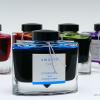 Hello. I'm wondering what dip pen nibs should a beginner that is serious about learning purchase? I'm okay with spending a decent amount of money if the quality justifies the price, considering I don't plan on randomly dropping the hobby and I'm absolutely *determined* to get good at calligraphy. Also: Does it matter what nib holder I purchase? If so, what would you guys recommend (for both a straight holder and an oblique holder)? Thanks in advance for any responses. =)
Hello. I'm wondering what dip pen nibs should a beginner that is serious about learning purchase? I'm okay with spending a decent amount of money if the quality justifies the price, considering I don't plan on randomly dropping the hobby and I'm absolutely *determined* to get good at calligraphy. Also: Does it matter what nib holder I purchase? If so, what would you guys recommend (for both a straight holder and an oblique holder)? Thanks in advance for any responses. =)- 15 replies
-
Hello I’ve been using dip pens for handwriting for a very long time now, but I’ve either used whatever nibs the pens came with, if antique, or just picked from whatever nibs came with it if it was a modern calligraphy pen set. I need to get a new one, and I’m trying to think a bit more systematically about nib selection. I handwrite a lot (I hate typing) but my handwriting is rather poor and scribbly, which is one reason I’ve used dip pens for so long - because they force me to slow down a bit and take greater care. I’m certainly no calligrapher. Does anyone have any recommendations for the best nib type for general-purpose handwriting with a dip pen? I need something with a reasonable flow rate and not prone to spatter when writing quickly. Thanks - suggestions much appreciated











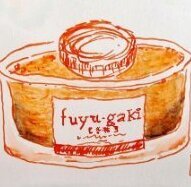
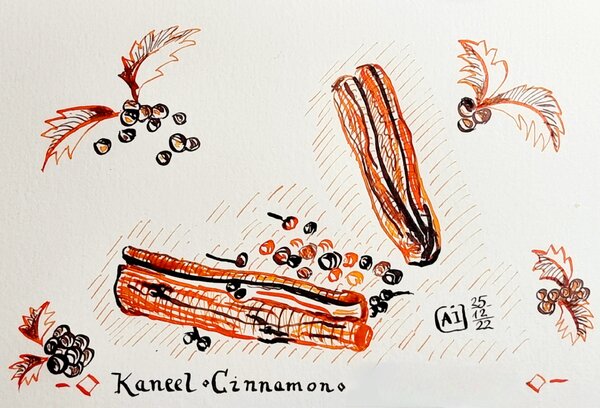
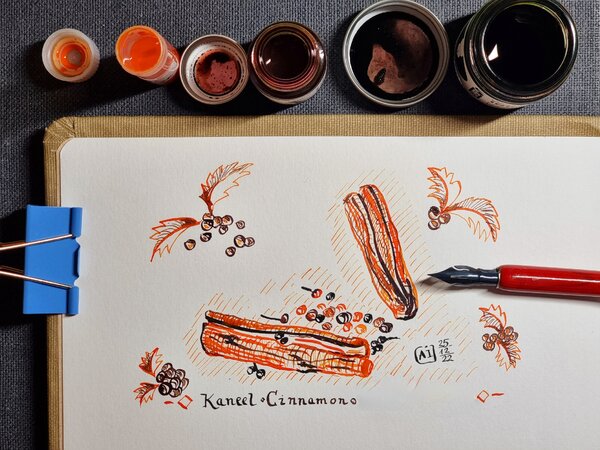
desaturated.thumb.gif.5cb70ef1e977aa313d11eea3616aba7d.gif)
